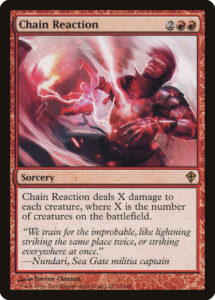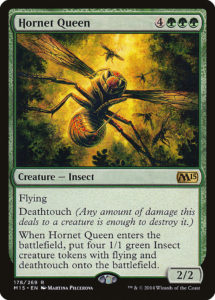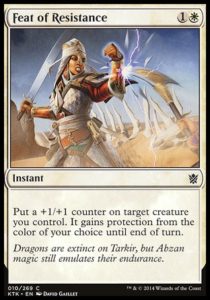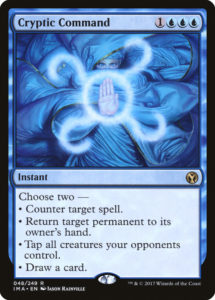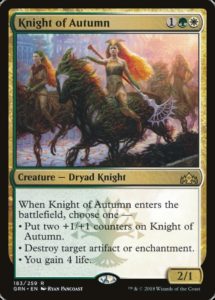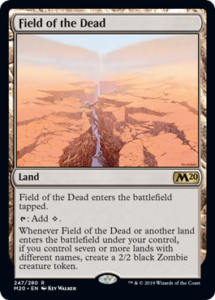We live in interesting times. Oko, Thief of Crowns dominates Standard while putting up strong results in Modern, Legacy, Vintage, and Pioneer. Oko isn’t dominating merely because his abilities are exceptionally strong; he has the additional benefit of incidentally invalidating entire strategies with his flexible suite of abilities.
We didn’t get here by mere happenstance. A sequence of events brought us to today’s status quo. But before we can talk about the invalidation of today, we need to talk about the invalidation of yesterday and just what invalidation means. And to talk about that, we need to talk about some Magic fundamentals.
Action & Reaction
Magic is a game about conflict. It’s a game where two players (or multiple players or multiple teams of players) vie for victory against one another. Almost all nonland cards in Magic play into this conflict, and we can divide them into two categories: threats and answers. You may well be very familiar with these terms, but I’ll nevertheless define them to hopefully get us on the same page.
Threats can win the game on their own. Creatures and planeswalkers are natural threats, since they can attack or use loyalty abilities each turn. Not all threats are created equally (e.g. Rumbling Baloth and the Questing Beast), but they share this quality of applying pressure.
Answers can nullify a threat. If threats are tools to win the game, answers are tools to stop your opponent from winning the game. Creatures are naturally good answers to other creatures (because they can block) and planeswalkers (because they can attack). Answers can also take the form of removal spells (Murder, So Tiny, Wrath of God) or a variety of restrictive effects (Stony Silence, Blood Moon, Ashiok, Dream Render).
Some answers can also function as threats. For example, imagine a format where the best threat is Lingering Souls. In such a world, Electrickery is a solid answer. However, Thundermaw Hellkite not only slays just as many 1/1 spirits, it also presents its own threat. In a world where Thundermaw Hellkite exists, it’s a lot more dangerous to play Lingering Souls. Let’s define our third term and the crux of this article:
Invalidation occurs when an answer is so effective at dealing with a threat that it becomes dangerous or incorrect to play that threat.
For an excellent example of invalidation, let’s go back in time five years.
Buzz Buzz
Hornet Queen and Scavenging Ooze are two powerful cards that were originally printed in 2011’s inaugural Commander release and reprinted in 2014. Hornet Queen is a color pie break because it gives green an army of powerful fliers (green is the worst color at flying) and a slew of effective creature removal spells (green is supposed to have to combine its creatures with spells or use their size for removal—but this is a line that has been crossed repeatedly in the last several years).
The main problem with Hornet Queen was not its immediate effect on Standard, but one that arose the next year. Dragons are Magic’s most popular creature type, and 2015’s Dragons of Tarkir was the first set to embrace them as a major set theme (Scourge did this to a far lesser extent). Normally, dragons were expensive Limited or Casual cards; the few Constructed playable ones were cards like Thundermaw Hellkite or Stormbreath Dragon—aggressively costed and designed to answer specific (white) threats. Dragons of Tarkir provided a slew of powerful, Constructed-playable dragons to all five colors, intending to make for the most dragon-filled Standard there ever was.
Unfortunately, almost every dragon was deathly allergic to hornet stings. Dragonlord Ojutai, Thunderbreak Regent, Dragonlord Dromoka, and Icefall Regent were all invalidated by a single member of a five-insect swarm. Even Dragonlord Atarka and Silumgar, Drifting Death couldn’t deal with Hornet Queen, and they cost a ton of mana! Hornet Queen managed to single-handedly invalidate almost all of the cool dragons in one fell swoop—sure, you could play with those dragons, but in a world where players employed Hornet Queen, you were inviting plenty of risk.
It’s Super Effective!
The problem with Hornet Queen is that she’s a resilient threat, a term we should definitely define.
Resilience is a property of threats. A resilient threat is more difficult to answer. Resilience is context-sensitive, so a threat that is resilient in one format may be less so in another.
Some examples:
If Doom Blade is the go-to removal spell of a format, then Doom Whisperer and Hypnotic Specter are resilient threats.
If Lightning Bolt is the answer of choice, then Kor Firewalker is resilient, Doom Whisperer is less resilient (it dies to two bolts), and Hypnotic Specter is not resilient.
If Mana Leak and Counterspell are common answers, then Doom Whisperer is not resilient, Hypnotic Specter is slightly more resilient (because it’s cheaper), and Shifting Ceratops is resilient.
If Path to Exile is the go-to removal spell, then none of the aforementioned are resilient, but Grave Titan and Hornet Queen are (because they have powerful enters-the-battlefield effects).
When threats are too resilient, they become too difficult to answer and answers fall out of favor. This was a huge problem in 2016-2017 Standard, where Heart of Kiran, Hazoret the Fervent, Saheeli Rai plus Felidar Guardian, Ramunap Ruins, and Gideon, Ally of Zendikar were all potent threats that were resilient to different kinds of answers but could be played alongside each other. In such a world where answers were weak but threats were strong, the best choice was mostly to jam resilient threats and race.
It’s not very effective…
Just as threats can be resilient, so too can answers be extra-potent. This brings us to our final vocabulary term: flexibility.
Flexibility is a property of answers. Flexible answers are able to deal with a variety of answers. As with resilience, flexibility is context-sensitive.
Some examples:
Lightning Bolt is more flexible than Fiery Impulse (even when Spell Mastery is always on) because it can target planeswalkers in addition to creatures.
Both Abrade and Lightning Strike have flexibility. In War of the Spark Standard, Lightning Strike‘s ability to target low-loyalty Planeswalkers like Narset, Parter of Veils is likely more valuable than Abrade‘s ability to destroy Golden Egg. But if this were Scars of Mirrodin Standard, the reverse would be true.
We are currently living in a world of extremely flexible answers, with Oko, Thief of Crowns as the primary culprit. His food production can invalidate aggressive strategies trying to do exactly twenty points of damage. His ability to downgrade creatures makes midrange threats without ETB effects into liabilities. The fact that he can also Elk-ify artifacts invalidates cards like The Great Henge that might otherwise see play. Teferi, Time Raveler was doing the same thing earlier in the year as he made cards like Search for Azcanta and Doom Whisperer into enormous liabilities while also disabling Wilderness Reclamation strategies.
What happened?
Oko might be much more powerful than intended, but he follows a pattern of more flexible answers we’ve seen the past year. Some of this is likely a reaction to the weak removal seen in 2012-2017 and the pendulum shifting back is going to lead to some jitters. But there’s also a clear culprit tilting the scales towards flexible answers: Magic Arena.
Magic Arena has been available for over two years, and while it was in closed beta for most of that period, plenty of folks were playing Best Of One. Two years is long enough ago for Wizards to respond to design needs of the format (and the Mythic Invitational, a major BO1 tournament, was back in March). Well, the problem with BO1 is that there are no sideboards. Decks that might normally be too fragile to win postboard games (like Nexus of Fate) could run roughshod over the ranked ladder (or completely distort the metagame around themselves).
Play Design specifically designed more cards to be flexible, main-deckable answers. Suddenly, players had Knight of Autumn as a beefy threat that could also blow up Wilderness Reclamation or undo a Risk Factor. We got Murderous Rider instead of Cast Down (which has a big restriction) or Vraska’s Contempt (which costs a ton of mana). We also saw fewer resilient threats like Rekindling Phoenix, Heart of Kiran, and Hazoret the Fervent. These flexible answers made for more interactive games in BO1, but they also began to invalidate entire card types.
Artifacts and enchantments are naturally resilient—each has at least one color that is unable to interact with them, and decks tend not to include maindeck answers. The cost for this resilience is that they lack the innate pressure of creatures and planeswalkers. In a world where suddenly everyone has incidental artifact hate (say, because Abrade or Oko are the best answers), artifacts might be invalidated as an entire card type.
A Fine Line
It will take time to figure out how to balance Magic best for BO1 and for BO3. Too many flexible answers can homogenize Standard by invalidating too many options. However, if there are insufficient answers, you get Field of the Dead.
Lands are the most resilient card type by design, since it’s awful if only one player gets to have them. Like how The Cauldron of Eternity is invalidated by everyone running Oko, so too might the cycle of Castles be invalidated by a card like Field of Ruin. Why skip a color or contort your manabase to play Castle Vantress when a maindeck Field of Ruin can cleanly invalidate your deckbuilding concessions?
Wizards want people to play with these new cards and enjoy a Standard with powerful nonbasic lands (unlike the Ixalan ones which you first needed to set up and transform). So, there was no Field of Ruin. There wasn’t even a Ghost Quarter or Encroaching Wastes to serve as a safety valve. And so, Field of the Dead, lacking any natural predator and exacerbated by Golos, Tireless Pilgrim, dominated Standard and led to the first full Standard banning of the post Play Design era.
There is a balancing act at play. Field of the Dead was a resilient threat in need of a flexible answer. Oko, Thief of Crowns is a flexible answer that’s also a resilient threat due to his obscenely high loyalty and ability to protect himself. (Seriously, if they were going to slap six abilities onto Questing Beast to make it into a planeswalker killer, why did they also make it unable to kill the two three-mana planeswalkers it released alongside?)
Artifacts, enchantments, and lands lose much of their resilience and therefore their power if most people can interact with them, but if they’re overly resilient, they’re unstoppable. Similarly, answers that are too flexible can similarly constrict a metagame down to the few cards resilient to them. The addition of BO1 makes a difficult task more so, and it’s one we’ll likely continue to see growing pains of. This is both a new problem and a very old problem for Magic, and time will tell how Magic reacts to the over-corrections of today.
And, as always, thanks for reading.
—Zachary Barash is a New York City-based game designer and the commissioner of Team Draft League. He designs for Kingdom Death: Monster, has a Game Design MFA from the NYU Game Center, and does freelance game design. When the stars align, he streams Magic (but the stars align way less often than he’d like).
His favorite card of the month is Heraldic Banner. It combines mana ramp/fixing (which normally controlling and goodstuff decks want) with a color-specific anthem (which is what monocolor aggressive decks want). There’s a lot of power there, but it presents a deckbuilding puzzle for players to find a solution to. It’s also the perfect kind of puzzle to include in Throne of Eldraine, since the format is defined by finding balance among ambitious monocolor mana requirements. And okay, it also works perfectly with Unlikely Alliance.

